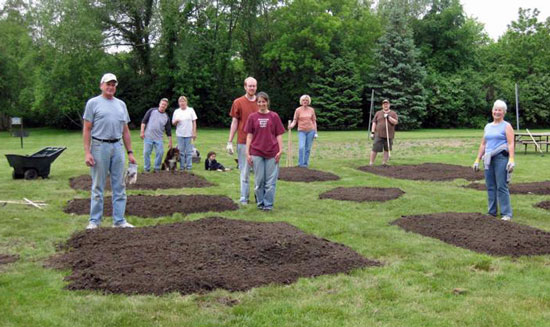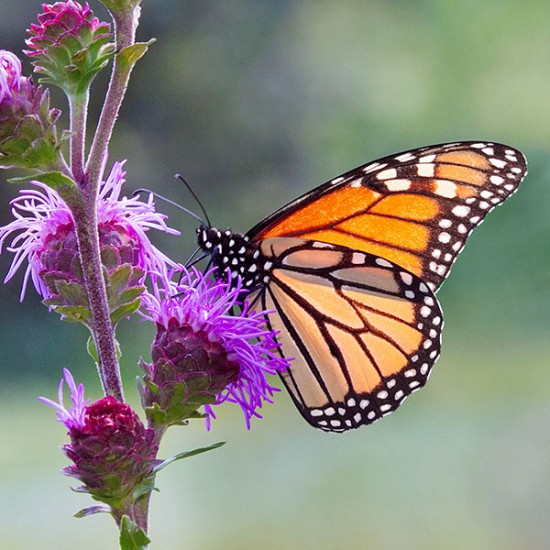I go to nature to be soothed and healed, and to have my senses put in order.
~ John Burroughs

This blog post comes courtesy of the Garden Designers Roundtable, who invited me to be their first-ever guest blogger. I’m honored and excited to be participating in today’s roundtable discussion, the theme of which is “Therapy and healing in the garden.” All photos are by Naomi Sachs.
Some Thoughts and Evidence on Therapy and Healing in the Garden
The idea that gardens and landscapes foster good health seems like a no-brainer, especially to gardeners and garden/landscape designers/architects. It’s like telling Newton that apples really do fall down. Sadly, though I’m preaching to the choir here today, many people still haven’t grasped this concept, and we can find all too many examples of landscapes that are anything but healing (picture, if you will, a parking lot at the mall…). At the Therapeutic Landscape Network, we focus a lot of our attention on the design of hospitals and other healthcare environments because – oddly enough – they tend to be so far behind as places that facilitate health and well-being on a holistic level. We’re getting there, but we still have a long way to go.
For today, since a big part of the TLN’s mission is to connect designers and health and human service providers with the research they need to design beautiful, nurturing, successfully restorative spaces, I thought I’d highlight some of the evidence that we’ve blogged about over the years. In this case, research that “proves” that being in and interacting with nature is, indeed, restorative for body and soul. This research is important because it’s positive ammunition. It’s what makes CEOs, and policy makers, and grant funders and our clients sit up and take notice (and change the laws and sign the checks!). I’ve provided a one-sentence summary of the research, with the title of each related blog post that you can link to for more information and full citations.
But first, for background, the seminal ‘View Through a Window’ study:
In 1984, Roger Ulrich studied two sets of patients, both in the same hospital, both recovering from the same surgery. The key difference: One group’s view from their window was of nature – grass, trees and sky; the other’s was of a brick wall. Ulrich found that the patients with the nature view complained less, required less pain medication, and made a faster recovery. Here, finally, was empirical proof of the salutary benefits of nature. Ulrich’s paper, published in the journal Science, got the attention of the medical community and legitimized the field of evidence-based design. Evidence-based design being the use of quantitative, and sometimes qualitative, research to design environments that facilitate health and improve outcomes. Since then, hundreds of studies have been published. Some, like those cited below, continue to demonstrate that contact with nature is good for people; some explore how people benefit, and what conditions are best for specific groups, needs, and situations (e.g., children; seniors with dementia; gardens for people who are immuno-compromised).

The evidence since ‘View Through a Window.’ A few good examples:
Trees, greenery, and other vegetation make neighborhoods safer and more desirable. They even play a role in boosting students’ grades and reducing the risk of domestic violence.
See “Healing the Neighborhood: The Power of Gardens.”
Plants in an office setting improve worker satisfaction, creativity, and productivity.
See “I Demand Satisfaction! The Role of Nature in Job Satisfaction.”
As little as 10 minutes spent outside improves attention in children with ADHD; neighborhoods with more green space improve body mass index of children and youth.
See “Nature Deficit Disorder: Getting Kids Outdoors.” For many more resources on nature-based learning and play for kids, visit our Get Out and Play! page.
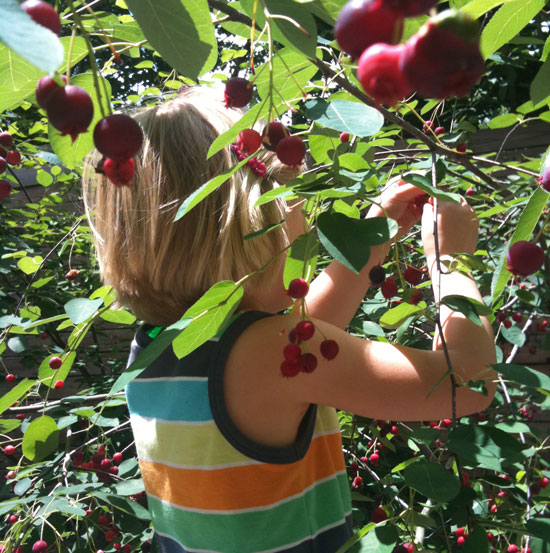
Gardening improves health and happiness, including reducing heart rate and blood pressure.
See “Horticultural Therapy in the Wall Street Journal.” Horticultural Therapy is “a professional practice that uses the cultivation of plants and gardening activities to improve the mental and physical health of its participants,” (definition courtesy of the Horticultural Therapy Institute). Hort therapists often work with occupational and physical therapists in a garden setting; gardens that are designed specifically for this kind of therapy are called rehabilitation gardens. For more information, see the horticultural therapy page on our website and for a really inspiring post about the power of horticultural therapy, see A Life Worth Living: The Garden as Healer.
Exposure to nature makes people more altruistic and generous.
It’s true, Nature Makes Us Nicer!

I hope that now that you’ve been introduced to the Therapeutic Landscapes Network Blog, you’ll stay awhile and read some of our older posts, and that you’ll visit us again for new ones (you can also sign up to have posts emailed to you). I welcome your comments, which can often lead to great dialog on the TLN Blog.
Many thanks again to the Garden Designers Roundtable for the invitation and warm welcome as a guest blogger. Visit the GDRT website (gdrt.wordpress.com), or click on the links below, to read other bloggers’ posts (and to see some great pictures) – it’s an excellent group, and each blogger has something interesting to say on the topic.
Genevieve Schmidt, North Coast Gardening: Designing a Landscape for Colorblind People
Ivette Soler, The Germinatrix: Plant a Garden, The Life You Save Might Be Your Own
Jenny Petersen, J Petersen Garden Design: Therapeutic Spaces
Lesley Hegarty & Robert Webber, Hegarty Webber Partnership: Homage to Ariadne: Labyrinthine Therapy
Rochelle Greayer, Studio “G”: A Tale About What Makes a Garden Healing
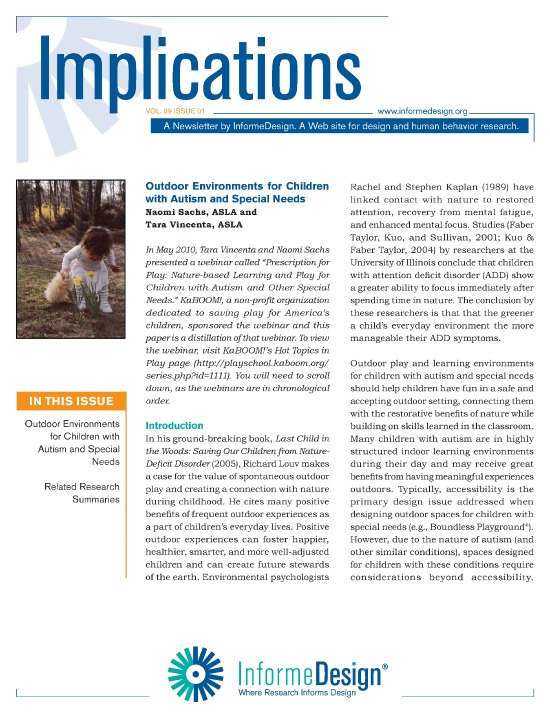 Hot off the press! InformeDesign’s latest issue of Implications (Vol. 9, Issue 1) just went live today, and it features an article by Naomi Sachs and Tara Vincenta, “Outdoor Environments for Children with Autism and Special Needs.” I mentioned this article in my April 13th blog post about Autism Awareness and Landscape Architecture month, but it had not come out yet.
Hot off the press! InformeDesign’s latest issue of Implications (Vol. 9, Issue 1) just went live today, and it features an article by Naomi Sachs and Tara Vincenta, “Outdoor Environments for Children with Autism and Special Needs.” I mentioned this article in my April 13th blog post about Autism Awareness and Landscape Architecture month, but it had not come out yet.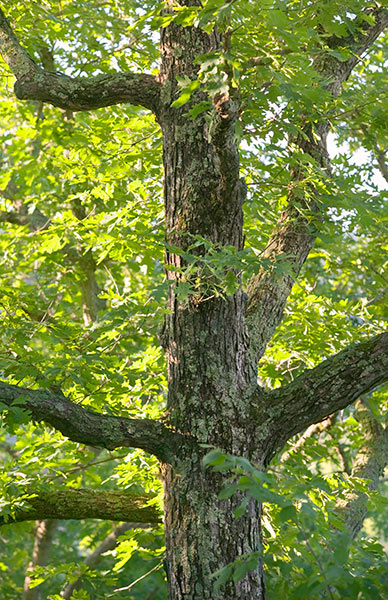

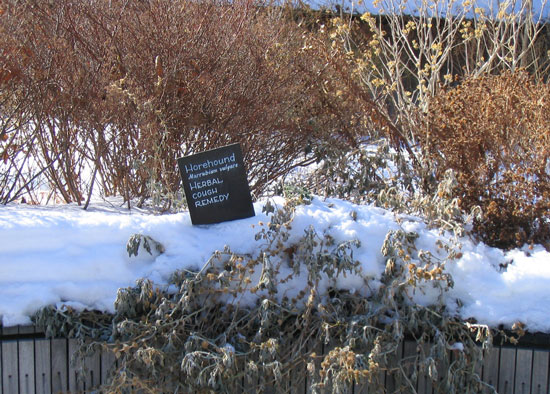
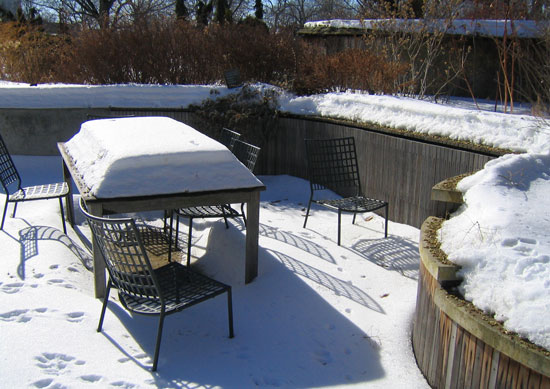


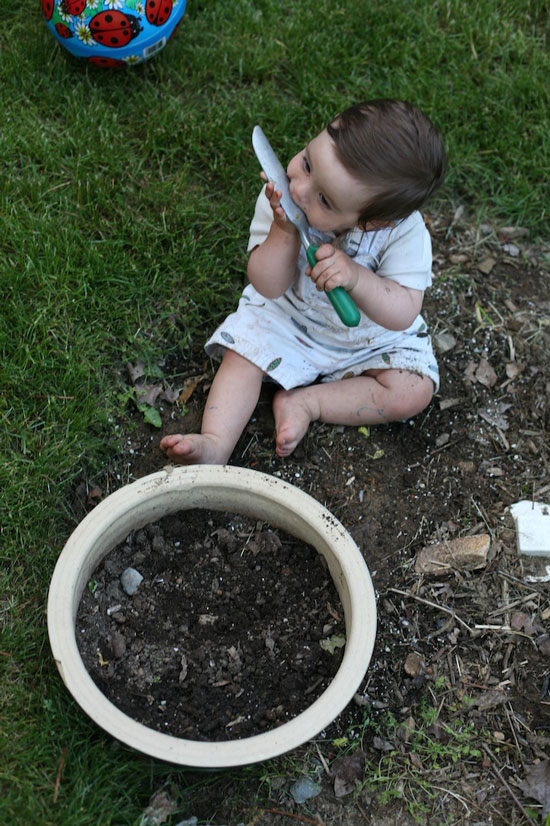 A big thank you to
A big thank you to 